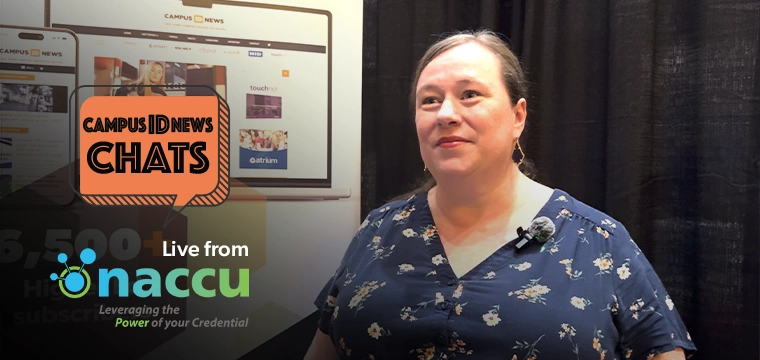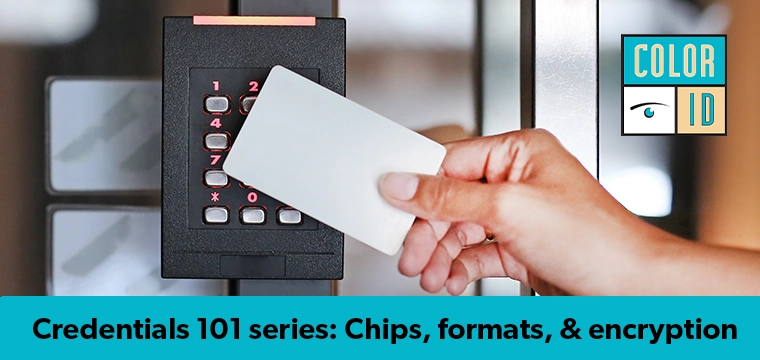Branding, architecture, and sustainability all play a role says HID campus lead
In this episode of CampusIDNews Chats we explore how to get buy-in for mobile credentials on your campus and lay the groundwork with your colleagues and administration.
Our guest Tim Nyblom, Director of End User Business Development for Higher Education for HID Global, starts with the concept of university branding.
But often the ID card relies on technology that was being used in the 1970s and 1980s. It is not reenforcing the university brand.
He highlights that universities are keenly focused on perception. They care about their technology. They care about innovation. They want to be modern. They care about their branding.They take care of the students in every aspect, whether that's different meal options for those with allergies, the green spaces on campus, the new buildings and upgrades – all to enhance that student experience.
But often the ID card relies on technology that was being used in the 1970s and 1980s. It is not reenforcing the university brand.
It's this type of messaging that Nyblom believes can move the needle with decision makers on campus.
Listen in to hear his suggestions to leverage architectural and sustainability committees, existing mobile-first initiatives, and other touchpoints to create buy-in.
To watch the video chat, click on the image at the top of this page.
TRANSCRIPT
Hey, welcome everybody to another installment of Campus ID News Chats. I am your host, Chris Form, publisher of Campus ID News.
We're going to talk today about mobile credentials, but from a totally different angle. We're not going to talk about technology. We're not going to talk about why to do it. We're going to talk about when to do it.
We're going to talk about how to get buy-in on your campus and lay the groundwork with your colleagues and administration.
There are some campuses that you've got it easy.
Upper administration says you've got to do this for one reason or another, or comes from the student side and administration says we have to do it. On a lot of campuses, you kind of may see the value of it from the card or the auxiliary service side, but you're having trouble getting at to move forward at the rest of the institution.
We've got Tim Nyblom, Director of End User Business Development for Higher Education for HID Global, with us today to help address this issue.
Tim and I talked at a conference about a month or so ago about how you can help move campus forward in this case.
Tim, thanks for joining us and helping kind of hit on this topic.
Yeah, Chris.
As always, appreciate the time and the platform.
So one of the things that I found interesting when we had that conversation a month or so ago was the idea of campus branding and the impact of technology on campus branding, and specifically our card technology, new and old, and how that impacts. Can you kind of talk through what you've been thinking along those lines?
Yeah. When you think about universities and you think about the perception of universities, right? They care about their technology. They care about innovation, right? They care about their branding. They want to be modern. They care about sustainability.
And this is, you know, a public message. They say this a lot, right?
They're taking care of the students in every aspect, whether that's all the different meal plans and allergy things that they look after, all the green spaces on campus, all the new buildings or retrofitting buildings, and just making everything really great to enhance that student experience, right?
But when you look at the reality of a brand, when you focus on the ID card itself, you're talking about technology that was being used in the 1970s and 1980s.
We're using a Magstripe. We're using a barcode to protect our buildings, to gain access, to pay for meals. Everything else has been upgraded, right?
Network security. I always used to make a joke like, you're not using Windows 95 now, right? You're not using floppy disks. You're not using Game Boys, right?
All that stuff is cool and, you know, it's going to be with us and we're going to reminisce on that. But when you look at the actual credential on a campus, there's so much more technology here now, especially with the mobile phones.
Like, if you are a campus that cares about your branding, you can't sit there and say, yeah, we care, but we're using a mag stripe. We're using a prox card that can be cloned, right?
And it's more of a message to university leadership.
Our card office folks, you know, public safety, people that deal with readers and credentials and access systems and cards, like, they get this, right?
It's trying to get that buy-in and show the other stakeholders on your campus the leadership on your campus, like, the reasons why.
Well, we've been talking, I remember from when I first started doing this forever ago, we talked about how the card or the credential is the thing that, to a student, that's always with them, that they're always looking at, that they see. So, it's kind of the most, it's the iconic campus brand. And yet, if your iconic campus brand is, as you mentioned, 20 years out of date or something, that says a lot and isn't really what anybody on the campus probably is looking for.
So, okay. So, great point. So, what do you do? So, you're in auxiliary services, you're in the card office, you're in the department and run the card office, whatever that might be, and you want to start to lay the groundwork for this. We all know that it's not something that happens overnight. But if you're not even having discussions on campus about it, where do you go? What do you start to do to, say, move that needle forward, you know, even if it takes a couple of years?
Yeah, it all starts with networking and conversations.
I would encourage folks to start reaching out to other departments, going to their meetings, right, hosting your own meetings, reaching out to people just to start the conversation on the why.
And there's been other resources that we've seen that have been successful at institutions lately. So, we've heard, or almost most universities now, colleges have some type of student government association, right, so, you know, those can be extremely powerful.
We've had some campus say that, you know, the students kind of hammered this message home to university leadership, and they wanted multiple credentials. They can act as that liaison.
There's other things like strategic planning and missions, mission boards or councils within a university.
If you look at a university's mission statement, right, this stuff exists.
They're talking about technology. We're being innovative, right. Again, how does mobile fit into that strategic planning boards? So that could be another angle.
You have your architectural and specifications areas, right, making sure as buildings are going up, you're putting in mobile-ready devices. You have those specs needed to take advantage of mobile when you're ready to go. So, if you're putting up a new building in two years, like, take a step back. Make sure the right hardware is in there, talk to those committees and those boards, and educate them on the devices needed.
And then finally, another one that's gaining more and more attraction is sustainability councils or committees.
We've heard universities say, this has actually put us over the edge of going mobile because we can lay out a business plan that says, hey, we're going to reduce printing plastic by a tremendous amount, and mobile helps us get there.
So when you think about all these different angles, start having those conversations and start the education process.
There's a couple things, and they're kind of almost to the point of being, you know, buzzwords or something, but more and more and more campuses I hear talking about sustainability and mobile first. And I would assume almost every campus has some sustainability commission or group or council going on, and almost every campus has some kind of a mobile first drive and plan there. So, getting involved in those or, you know, talking to those folks certainly would be a good piece of that, I would think, so good points.
How about we talked a little bit about this is a change management process. It's not, you know, it's not you click a button and you go from one to the other. So, in that process, I think that's a way, you know, you also have to change your way of thinking and change the rest of your administration's way of thinking about what the process is. What do you got to say about that?
Yeah, 100% true.
When you think about universities and colleges over the last 20 years, things have been moving in one direction, right? Typically, there's a card office, you print cards, you do these types of things. Again, very siloed.
And when you think about mobile, I encourage everybody to take a step back and look how this could actually transform the campus for the better.
And I view it to your point, Chris, like it is a change management project and change is hard.
And whether your campus is small, medium, large, right, you have hundreds of hardware solutions out there, software buildings, or whether you're a small campus, it can be a lot of work or it could be not as much work, but it becomes very rewarding.
And when you think about change management, you're focusing on the planning, the implementation process, managing that change within the organization. Again, going back to the stakeholders and departments, you're thinking forward of how this change is going to be accepted. You've got to embrace it effectively.
You've got to manage the transitions, the cultural shifts, the technologies, the processes, the personalities. All of this comes into play. And that's why I think it's more of a change management project. And I think any institution that has gone through this would probably agree with that line of thinking. And that doesn't mean it's too hard to do. It just means you need to think about it from the standpoint of this is an ongoing process. It's not something you start and you finish on day one or day 10 or something.
The stuff that you're discussing here, you've got to start to lay the groundwork and work toward that. I think about it because of working on some fundraising initiatives for organizations that I've been involved with where you're trying to build a building for a school or something like that.
And you're building it not necessarily for the kids that are in school today, but you're building it for the kids that will be coming to the school in a couple of years or the next generation of students and things. I think that's a really valid way to look at it too.
Yeah, when you think about the campus, I like to say you think about the generations I've had slides up and I've talked to people about this, but all the different generations.
So it's about Gen Z and beyond, right? Gen Z is driving that demand today, going to be decision makers tomorrow, right? They're digital natives. They're used to this type of stuff. They expect convenience. They expect speed, right? They have demand for sustainability and environmental responsibilities, right? They have a desire for personalization and control, like self-service. They really like that kind of stuff.
And then you have to think about Gen Alpha.
Why I think it's even more important is when you think about Gen Alpha, that's the generation after Gen Z, but they have grown up in a fully digital world, right? They don't know plastic. They're immersed in it. Super users of mobile, instant everything, expecting ease of use and convenience, right? And they are entering universities in the next five to eight years.
So when you talk about this, you know, mobile credentials, right? It's building for what is coming. And, you know, again, some universities might say we need to do that now. We need to do it one year, two years, three years, whatever the case may be. But these students, these generations are coming and this is all they know, right?
It's going to feel very weird potentially to them, right? You got to come down to this particular office, get a card. What is in this card? What do I do with this card?
And another thing that's I think important to call out here is when we think back on, again, campuses over the last 20 years, there was a certain way students received information. You used to walk into a card office and chat with people, get your card printed, get your photo taken, right? And that was the way. Well, we all know people don't do that anymore, right? They're getting information so many different angles. They don't have to go into offices anymore.
People are using apps, emails, social media, you know, push notifications, whatever the case may be. Students are used to this world now. They don't, you know, they're not used to walking into offices and having to do all this.
So, again, it's just another thing to think about when you're talking to your stakeholders and leadership on the why and how to get this done.
Yeah, I think that's right. The point that I would make to a campus administrator or leader would be it's not going to get any easier. You know, the next group of students is not going to expect this less than the current group does. It's just the opposite. The demand is going to get more and more and the impact on campus branding is going to get bigger and bigger with each subsequent year of incoming students that comes around. So you're putting off potentially the inevitable, I think, would be the idea there.
Yeah.
And one of the point to add there is, you know, when you think about a phone, just in general, in this access control industry, higher education, vertical, when you think about this piece of technology, it is one of the first items really that has mainstream appeal when you think about it.
So you can talk about, OK, yeah, we upgraded our access control system. We installed a thousand, you know, cameras. We're putting panic buttons like we're doing all this kind of stuff. We're upgrading our trash cans. We're doing our buildings right.
But to a student and what they interact with every day and how it enhances their life on campus, this is the first item with mainstream appeal. That is all they know. That is all they carry. That phone can power the campus through efficiencies, through experience, through better security. And, you know, it ties everything together.
So I like to say, yeah, it's really mainstream appeal. Everybody knows what a phone is.
All right. Perfect way to end, Tim.
I appreciate it. Thanks for being here. And to everybody out there, thanks for watching.




